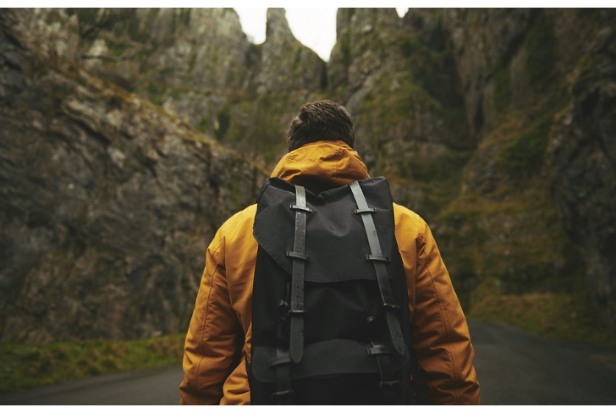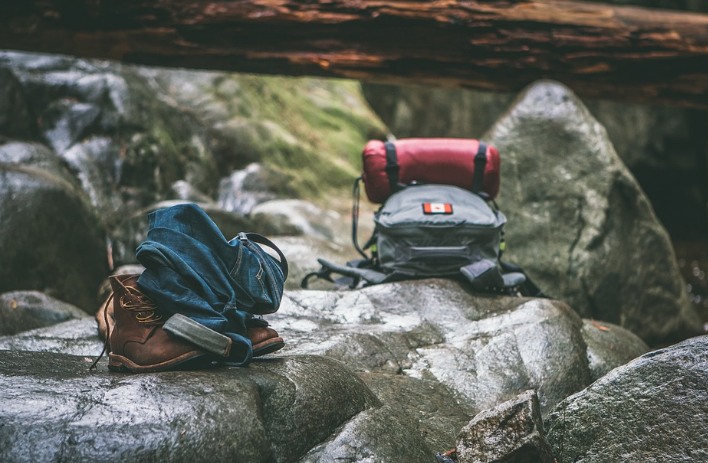
It goes without saying that you cannot choose what to wear until you are aware of the circumstances you are dressing for. Keep in mind that the weather at the trailhead or in a nearby town might not be the same as it is at the place you’re hiking to. Storms may be more likely on summits and high elevations because they are typically colder and windier than nearby lower locations. It’s better to be overprepared than underprepared, so prepare for the worst weather you could possibly experience.
Important Factors When Choosing Hiking Clothing
While looking good on the trail is a bonus, there are factors to consider before you buy that adorable (yet not so functional) jacket or shirt for the trail:
1. Your safety: The environment you’re hiking in and the potential weather conditions will have a big impact on the clothing safety. For instance, even in the summer, it may be wise to exercise caution and wear long sleeves and pants when hiking in an area where Lyme disease is on the rise. Additionally, if you plan to hike through the rain, a windproof rain jacket is essential because rain and wind often go hand in hand.
2. Your comfort level: There is a reason the term “cotton is rotten” exists in the hiking world. During exercise, our bodies use sweat to control body temperature. Cotton holds onto water and directs sweat toward your body, keeping you warm in warm weather and cool in cold weather. Merino wool, polyester, and nylon are examples of materials that wick sweat away from the body and can keep you much more comfortable throughout your hike.
The fit of the clothing is crucial, in addition to the material. When I first started hiking, I made the error of choosing clothing that was more fitted and tight in an effort to look good on a hike. However, it also meant that my range of motion was constrained, which made hiking in these clothes a rather unpleasant experience. Choosing a roomier fit gives you more flexibility and comfort while hiking. Let’s face it, no one looks good on a hike when they are miserable and uncomfortable!
3. Clothing versatility: Investing in high-quality equipment can be expensive, so think about packing multipurpose clothing. Two items of clothing come to mind: a) light hiking shirts with long sleeves that can be rolled up and fastened; and b) convertible pants with pant legs that zip off into shorts.
What Shoes To Wear Hiking
An uncomfortable hike is a result of sore feet. Any reliable, closed-toe athletic shoes you have should be worn for your first few hikes. (Simply choose a pair that you don’t mind getting dirty.) For most easy to moderate trails, sneakers work just fine. However, for steep hikes, you might want to wear shoes with a little more traction and support. Are you all set to purchase a pair of hiking-specific shoes? You have a few choices.
Trail Runners
Don’t be misled by the name: trail running shoes aren’t just for running quickly. They are lighter and more nimble than boots while still providing grip and support, which is why many hikers choose them. Trail runners are a fantastic choice for light to moderately loaded dayhiking or even backpacking. Try these if you don’t need additional ankle support, enjoy feeling free of bulky shoes, or enjoy moving quickly.
Low- Or Mid-cut Boots
Try hiking shoes for excursions that require a light or medium-weight backpack. Although cuff height is a matter of personal preference, you’ll generally need more ankle support the heavier your pack is.
High-top Hiking Boots
Consider a boot that rises above your ankle bone if you are prone to ankle injuries or will be carrying a heavy pack. These are fantastic for long treks but frequently too much for quick day hikes.
Materials
Choose hiking shoes that are waterproof and breathable. You may want waterproof boots if you plan to spend a lot of time crossing shallow streams, hiking through snow, or mud. Just bear in mind that these boots are frequently much less breathable than their non-waterproof counterparts. This causes sweat to condense, and if you step into a deeper stream or puddle while wearing the boots, it will take longer for them to dry. Many hikers prefer synthetic, breathable summer hiking shoes that dry quickly if they do get wet (like those with mesh paneling).
Consider the outsole, which is what keeps you anchored to the trail, in addition to the upper material. If you frequently hike in slick mud, you might want larger, evenly spaced lugs because different soles are designed for different surface types. In order to maximize surface contact with the ground, look for shoes with flat soles and sticky rubber if you anticipate doing a lot of rock scrambling.
Given the variety of models available, it’s a good idea to try on several pairs in the store to determine which one fits you the best. Your preferences may alter as you hike more. All you need to do is make sure the shoe or boot you buy fits properly and is supportive enough for the type of terrain you intend to hike in. You can get fit assistance from a salesperson at your nearby retailer. Plan for a break-in period rather than wearing your brand-new boots out on the trail right away, especially if they are heavy hiking boots or other leather shoes.

Underwear For Hiking
Underwear
Wear whatever you feel most comfortable in on your first hike. Do you have a favorite pair of boxers to wear to the gym? You might enjoy wearing them while hiking if you do. Your preferences may alter as you begin taking longer hikes, overnight trips, and backpacking excursions. Many hikers favor wool or synthetic underwear over cotton. Just make sure what you’re wearing is comfortable for prolonged periods of movement—prominent seams that could chafe are a no-no.
Sports Bras
Regular bras are typically less comfortable for hiking than sports bras. Choose a bra with low-profile or wide straps if you’re carrying a heavy pack; steer clear of chunky buckles or protruding seams because they may rub against the straps of your backpack. Your go-to sports bra for other activities will probably work just as well for hiking.
Socks
Most of the items on this list can be worn with any athletic clothing. However, socks are one item where you should spend more on hiking-specific clothing. A quality set of socks can mean the difference between a hike that is enjoyable and one that results in blisters and pruney toes.
The cushioning provided by hiking socks will keep your feet comfortable over long distances and they frequently prevent blisters better than regular socks. They are typically made of wool or a quick-drying synthetic material. Choose a pair of socks that is taller than the cuffs of your hiking shoes to minimize chafing and maximize comfort. Look for wool or synthetic socks that are the right weight for the weather you’ll be hiking in (lighter in the summer, heavy in the winter). Select the level of cushioning that feels comfortable for you, but make sure your socks fit snugly because bunching or slipping can cause discomfort and eventually blisters.
Consider wearing liner socks underneath your hiking socks if you are prone to blisters in order to reduce friction against your skin. Many trail runners and long-distance hikers prefer compression socks because they encourage blood flow and hasten recovery.
Adapting Your Hiking Clothes For Each Season
Naturally, your location has a significant impact on what you decide to wear while hiking during each season. However, in general, a few quick adjustments can help you wear your hiking gear all year round.
Winter
It’s all about layers when the temperature drops. To protect yourself from the elements, wear baselayers, insulating layers, and outer layers that are wind- and water-resistant. Not prepared to spend money on a winter hardshell yet? If it fits over your warm clothing, your rain jacket can also be used in the snow.
Your hiking boots can survive in snowy conditions if you pair them with warm socks and vapor barriers.
Spring
At this time of year, the weather can change quickly. Prepare for rain and pack extra warm layers in case the weather changes while you’re hiking. Do you want to be prepared for anything? You can adjust on the trail by wearing a pair of shorts over leggings or a pair of zip-off pants. Wear boots or shoes with wide-spaced lugs in the spring because it’s mud season.
Summer
It’s easiest to dress for this warm season. If you plan to hike at a high altitude or in the evening, bring an insulating layer and consider sun protection.
Fall
Expect a wide range of conditions in the autumn, just like in the spring. Bring a hat, gloves, and a wind-blocking layer (your raincoat can serve as a windbreaker).
What To Bring On A Hike
Backpack
The bag that will hold all of your equipment is where it all begins. For shorter hikes, it’s worthwhile to bring a lightweight, waterproof backpack because it not only makes the hike more enjoyable, but it also protects your belongings from falling water when you pass by waterfalls or when it suddenly starts to rain, which can happen in Hong Kong. A larger backpack is necessary for longer treks that call for more food, water, and perhaps additional clothing. Make sure your backpack is securely fastened and is in good condition to prevent it from falling or snapping halfway off your shoulders.
Food And Water
In particular when hiking in the heat of Hong Kong, hiking can be exhausting and it’s easy to become dehydrated. Bring at least two liters of water with you at all times to stay hydrated. Bring hearty snacks that you can easily munch on while hiking, such as energy bars, jerky, and trail mix. The convenience of being able to drink while hiking is made possible by a hydration pack or vest. Bottles are typically heavier, but if you prefer this, put it somewhere you can access it from your backpack. The majority of hiking organizations will emphasize how important it is to avoid bringing disposable water bottles because hikers often abandon them on the trail, adding to the plastic waste and other trash that pollutes the environment.
First-aid Kit
Carrying various first aid supplies, such as antiseptic wipes, adhesive wound-closure strips, medical adhesive tape, and insect repellent, pays off in the event of an accident. Paracetamol or other painkillers like antihistamines, which are used to treat allergic reactions, could also be helpful.
Health And Hygiene
Remember to keep it as sanitized and clean as you can given the historic times we are currently living in. Bring a mask and hand sanitizer to use before and after the strenuous hike or when the path becomes congested.
Navigation Tools
Tools like a paper map or a small compass are very helpful, especially on longer trails where your smartphone may lose its signal.
Conclusion
Now that you know what to wear hiking. Since you’ll be equipped for the cold, rain, or sun, you won’t be left stranded if the weather suddenly changes.
To make better plans and pack the right gear, it is crucial to do some research on the weather the days before you head out to the trails.








